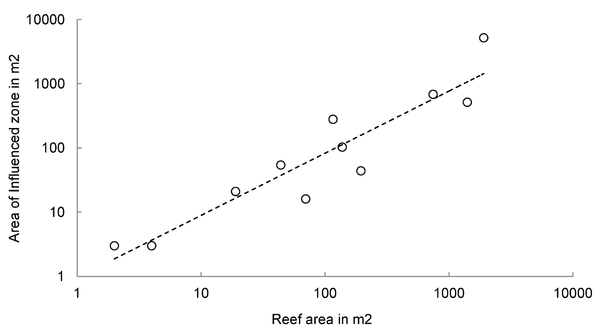| Vorm en grootte oesterriffen Oosterschelde | |
|---|---|
| Context | Sedimentbalans en oesters in de Oosterschelde Oosterschelde |
| Type | Condition |
| Decompositie type | IOR |
Shape and size of natural oyster reefs
The aim of research on natural oyster reefs was to provide professionals in the field with forecasting tools, predicting how artificial oyster reefs will behave in the future regarding their effects on the tidal flat.
Reefs located low in the intertidal area are higher than reefs located high in the intertidal area, indicating possible growth restriction up to a certain height (exposure time). Reef height however also shows strong correlation with reef length (R2=0.87), width (R2=0.94) and reef area (R2=0.93) which could indicate that reef height is part of a characteristic reef shape rather than a result of growth restrictions (Walles et al., 2014).
Table 1 presents the reef characteristics of eleven natural reefs and their effects on the surroundings, including area of the influenced zone. From the table it can be observed that the area of the natural oyster reefs analyzed range from 2 m2 up to 1908 m2. The area of the influenced zone range from 2 m2 up to 6749 m2.

Reef area and the area of the influenced zone show a power law relationship (Figure 1). The area of the influenced zone increases proportional to increases in reef area.

It is possible to do the same kind of analysis and relation taking in account different characteristics. Reef length, of the analyzed reefs, varied between 1 and 61 meters, reef width between 1 and 45 meters, and reef height between 0.20 and 1.08 meters (Table 1). Reefs of C. gigas in the Eastern Scheldt seem to have a characteristic shape with a width of 76% of their length. All reef parameters show correlation with the area and distance of the influenced zone. Reef length, width and height show a power law relationship with the area of the influenced zone. Reef width and height also shows a power law relationship with the maximum distance of the influenced zone, whereas reef length shows a linear relationship. The maximum sediment height at the lee side of the reef is around 40% of the reef height itself. Using stepwise linear regression with forward and backward substitution it was found that reef length was the most predictive factor for both the area and maximum distance of the influenced zone (Walles et al., 2014).
Shape and size of artificial oyster reefs
The three artificial oyster reefs as build in 2010 at the locations Viane and the Val in The Netherlands measure approximately 100 meters long by 10 meters wide.
De View-Navigation (VN) pagina's.
De links naar andere pagina's.
| Onderdeel van | |
|---|---|
| Instantie van | |
| Betreft |
Draagt bij aan.
| Draagt bij aan | Sedimentatie Oosterschelde |
|---|---|
| Waarde | + |
| Opmerkingen |
De pagina's die linken naar deze pagina.
Dit element heeft geen subelementen.
| Komt van | Type | Connectie type | Conditie | Waarde | Opmerkingen |
|---|---|---|---|---|---|
| Programma van eisen oesterriffen Oosterschelde | Depends | afhankelijk van |






